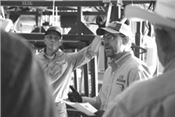|
Cattle Preconditioning Helps Improve Odds For Return On Investment

Jeremy Powell, Division of Agricuture veterinarian, discusses aspects of preconditioning such as
vaccination and castration. His demonstration was part of a cattle field day
at the LIvestock and Forestry Station in Batesville. Taken April 16, 2019.
U of A System Division of Agriculture photo by Mary Hightower.
BATESVILLE, ARK.
Arkansas cattle producers looking to improve their return on investment should consider preconditioning calves before taking them to market, extension specialists told attendees at the Livestock and Forestry Station field day on Tuesday.
The field day, “Improve Your Odds for ROI,” featured a look at Arkansas’ new preconditioning program, GoGREEN, and examined how preconditioning adds to producers’ bottom lines. A cattle genetics expert offered specifics on pregnancy detection and the benefits of a defined breeding season.
The field day ended with a hands-on demonstration of vaccination, deworming and other recommended practices for calves.
“It was a good day of learning and it was great to see our participants asking good, even tough questions, of our experts,” said Don Hubbell, resident director of the Livestock and Forestry Station, part of the Arkansas Agricultural Experiment Station.
Preconditioning
Preconditioning is a collection of best management practices meant to make calves healthier and heavier by the time they go to market. Preconditioning includes vaccination, ridding them of internal and external parasites, and being fully healed from dehorning and castration. This also include ensuring that calves understand how to eat from a bunker and drink from water tanks.
Shane Gadberry, professor and extension ruminant nutrition specialist for the University of Arkansas System Division of Agriculture, said preconditioning also means handling calves so they aren’t afraid of people, and can be approached to receive medical care, if needed.
“The one thing that makes preconditioning easy is having a controlled breeding and calving season,” Gadberry said. “It’s a lot easier to implement a preconditioning program when most calves are born and weaned around the same time; either once or twice a year.”
“I believe preconditioning is the apex, the pinnacle of cow-calf management,” said Eric Bailey, state beef nutritionist for University of Missouri Extension.
“The majority of the value of a preconditioning program is not in the premium at sale,” he said. “The bottom line to an individual cow-calf producer is that you sell more pounds of beef.”
Bailey pointed to research showing that preconditioning can help lower the chances of a calf contracting bovine respiratory disease, which typically results in a 75 percent feedlot mortality rate. Those losses amount to $2 billion a year.
A study of 11 years of preconditioning on a single farm found the average profit per head was $68.95, with 63 percent of that profit due to additional pounds sold.
In answer to an audience question, Bailey emphasized that preconditioning isn’t a matter of using just one tool from a toolbox.
“You can’t outrun bad management with a bottle,” Bailey said. “Vaccines aren’t the guarantee you’re going to have performance from these animals.
“Consider the whole system,” he said. “Vaccines are just a component of a preconditioning system.”
Bailey also cautioned that preconditioning is a commitment.
“Get your cow-calf management right before you attempt to dive blindly into preconditioning,” he said. “If you’re not there yet, get with your county agent.”
GoGREEN
The Arkansas Cooperative Extension Service rolled out its GoGREEN preconditioning program this past year. Gadberry discussed how timing for calving can affect prices producers receive at market, if they immediately sell calves as six-month-old weanlings.
Pointing to a graph showing steer price fluctuations through the year, Gadberry noted that prices were “lowest in fall, because we produce a lot of calves in the spring. It’s sheer supply relative to the demand.”
Gadberry recommended retaining calves an additional 60 days after weaning, in order to add weight.
“As we add weight, we’re adding dollars,” he said. “In recent years, we’ve seen market prices increase from May to July. Producers with fall-born calves often wean in May. Holding those calves a couple of months when grass is usually abundant can add dollars to the bottom line.”
Feeding for gain
Paul Beck, beef cattle extension specialist for Oklahoma State University, presented research that pointed to use of cool annual forages to promote calf weight gain in the fall and spring.
Compared to fescue or hay and supplements of mixed feeds, “wheat pastures offer us a unique resource with some great potential for weight gains,” he said. “It’s a cheaper and more profitable option for growing purchased or retained stocker calves.”
Breeding, calving and preconditioning
Charles Looney, extension cattle genetic specialist for the Division of Agriculture, emphasized the bottom line benefits of moving to a defined breeding and calving season.
“I grew up on a farm that had calves all year,” he said. “Calving all year is not what is best. What is most cost-effective is for vaccinating and deworming to be done on all calves at the same time, instead of individually.”
Looney said ranchers needed to look at testing reproductive tract soundness for both heifers and bulls, especially with research showing a $22 return on every dollar spent on breeding soundness testing.
Looney demonstrated the accuracy of ultrasound in evaluating whether a heifer was pregnant for not.
“It’s like having your hand in your pocket and knowing how much change is in there,” he said.
Looney said artificial insemination could go a long way to helping ranchers meet the goal of a defined breeding and calving season.
“You don’t have to worry about a bull. Bulls tear things up; they do a lot of damage,” he said, adding that when it comes to breeding, “Don’t mess with heat detection. Just breed on time.” ∆
|
|